Japanese finches: description and content at home
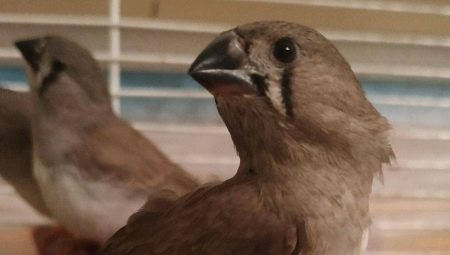
Amadin is a very common breed of birds that was artificially bred... Unfortunately, information about the ancestors of this bird is so contradictory that they have not yet been established. Among the possible progenitors there are sharp-tailed finches, Chinese. Unlike the ancient snow-white Japanese finches, today the color variety is impressive. This unpretentious bird, which can be bred independently, has been in constant demand all over the world for many years. After all, she does not need to fly often, she patiently gets along with her neighbors.
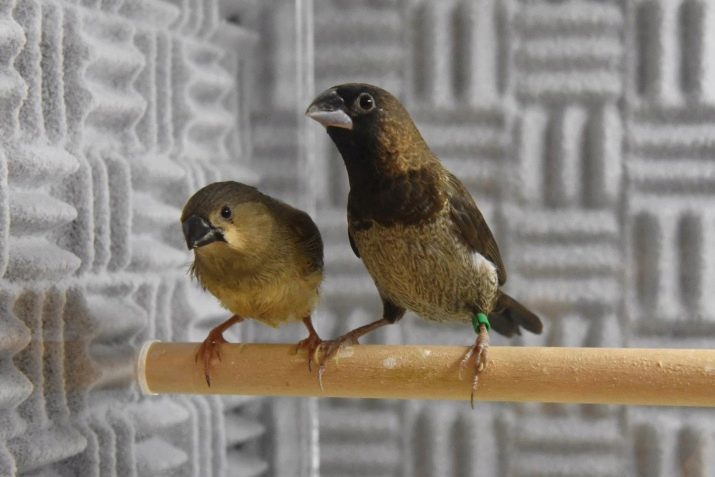
Bird features
Amadines have a thick beak, curved in an arc, plumage of a dense type. The color can be any - mostly variegated, bright birds, with contrasting shades of feathers. Females have a faded color, as well as young animals, males are more catchy. There are crested representatives. The breed belongs to the family of finch weavers.
The size of the birds is small, and the colors of the Japanese can be different:
- the top is brown;
- the rest of the body is grayish or snow-white;
- there are representatives of a monochrome color - reddish, white, yellow;
- given several hundred years of breeding the breed, the Japanese have quite a few varieties that differ in different combinations of shades;
- it is often possible to observe the asymmetry of the color of the spotted type.
The bird's beak has an original shape and color: at the top it is black and blue, at the bottom it is light. The colors of the Japanese are indistinguishable by gender, but the singing is different.
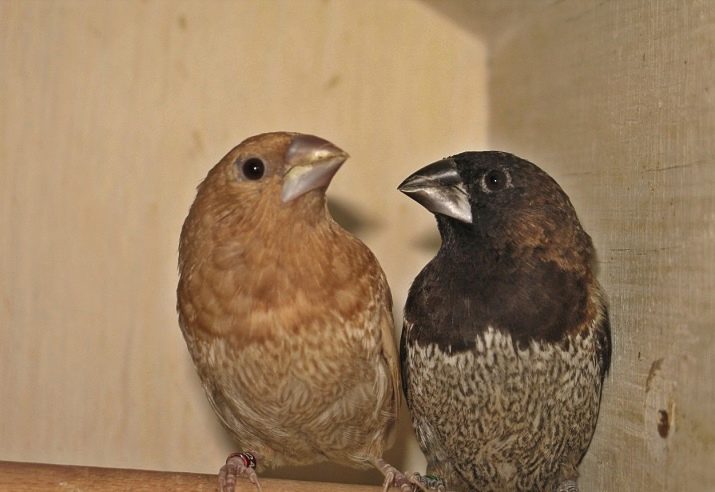
This breed very livable and undemanding in carebesides, she perfectly feeds weaver chicks, if necessary.
Specific traits:
- loves the society of birds;
- calm, ill-tempered disposition;
- gets along well with their own kind in the same cage;
- during the nesting period, it is necessary to separate the birds in pairs.
White Japanese are weaker by nature, have fragile health, less fertility, grow more slowly, and often have physical disabilities.
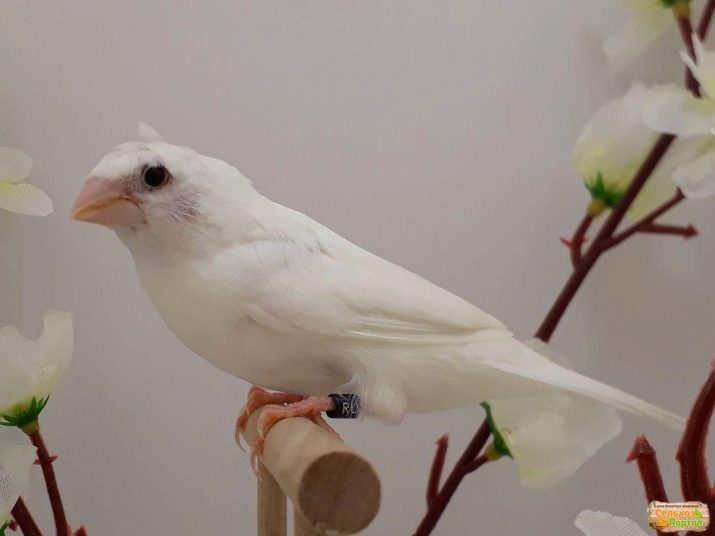
In the 20th century, the crested variety of the Japanese was bred. Tufts can vary in color and shape:
- bundle-shaped;
- lush and thick;
- double type.
And more recently, the curly Japanese were bred. They have curled plumage in the chest, back and shoulders.


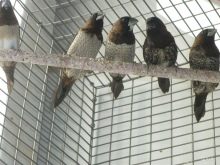
Growing conditions
Before deciding on the home maintenance of a finch, you need to familiarize yourself with the conditions for its cultivation. It is better to buy a bird in a pet store: evaluate the color, choose the one you like. If you decide to start breeding, the birds should not be more than a year old, and it is better to postpone the purchase for the autumn period. Be sure to appreciate the appearance - it must be healthy. Avoid buying overly emaciated, disheveled, bald birds. Birds are transported in a transport cage, therefore make sure that it is neither tight nor too large, cover it with a cloth.
After bringing the bird home, allow it to get used to for a while. Do not put in a common cage, as quarantine is necessary... At first, finches are kept separately to identify health problems so that a sick bird cannot infect others.
In the early days, appetite, behavior, and stool in the finch are assessed. Ideally, feces are donated for analysis. After a month, if no suspicious signs are found, you can plant the bird with your neighbors.
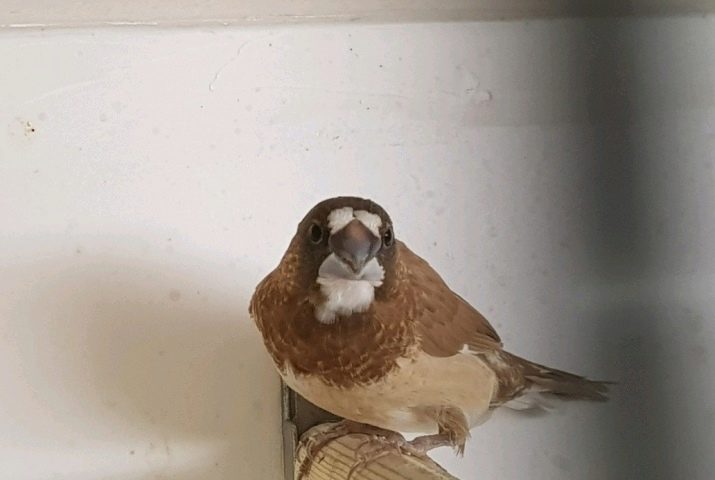
Amadins should not be removed from the cage unnecessarily.... They are seriously frightened, and careless movement can lead to the death of the bird. It is better to move birds from one enclosure to another, catching birds with a net at night. The adaptation of the Japanese goes quite smoothly, calmly, if the conditions of detention are respected: the birds are warm, dry, feed well and shelter from drafts. You can keep birds in cages or aviaries.

Cells:
- very convenient option for apartments;
- can be metal, wood, combined;
- the optimal location of the door is just below the perch so that the bird does not accidentally fly out when serving food or drink;
- it is necessary to be equipped with a pull-out pallet;
- the size is chosen based on the number of birds, their size;
- the height of the cage must be greater than the width;
- round, diamond and trapezoidal cages are not suitable for this breed;
- you should not buy cells with decor such as balconies, windows, towers.
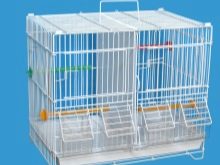
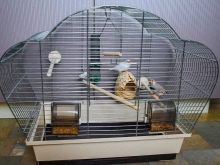

Aviaries:
- the best option for keeping birds;
- size and shape may vary;
- in this room, the conditions for birds are close to natural;
- in open-air cages, finches grow healthier;
- installed in a bright corner of the room;
- it is necessary to equip it with wooden frames, cover it with boards;
- the size of the doors should allow a person to easily enter inside;
- the occupancy rate cannot be exceeded.
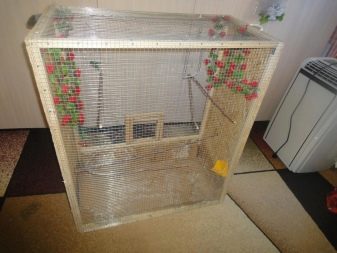

Correct care
The Japanese are quite peaceful, fearless breed, and the cage can be safely placed at any height. Approaching the cage will not affect the bird's mood in any way. Do not place cages near heating appliances, if the room is heated by a stove or fireplace, do not place the cage under the ceiling.
It is very important to keep birds clean:
- dampness, dirt are very harmful to finches;
- it is necessary to clean up the cage or aviary at least every other day;
- dirt from the poles is cleaned with a knife, then they are treated with boiling water;
- tanks for water and food are washed every day with soap and hot water, wiped dry;
- in the heat, the water changes often;
- do not place containers for water and drinking nearby, and do not place them under the perches.
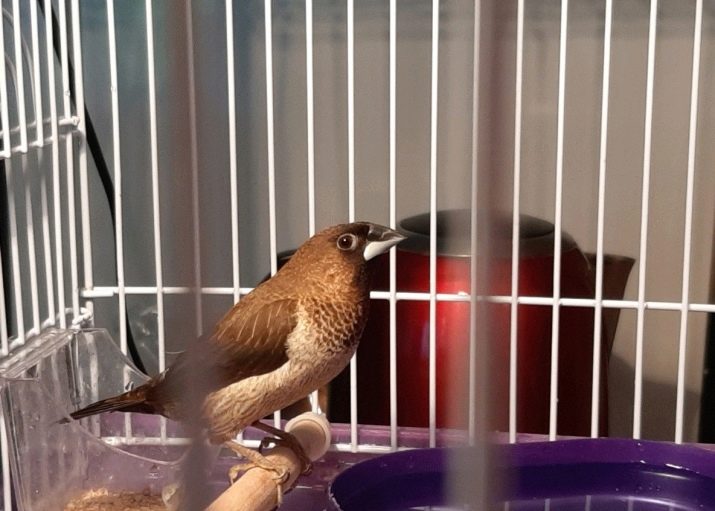
Amadins love water and enjoy swimming. Therefore, from time to time you need to give them this opportunity by hanging a bath with a small amount of water at room temperature in the cage. Water procedures have a good effect on the health of birds, on the condition of their feathers. For birds of this breed, sunlight is important; a lack of lighting should not be allowed. Otherwise, the metabolism of birds may be disturbed, a number of diseases will arise. In the summer, you need to put the cage outside for about 40 minutes a day.
This breed does not like cold and dampness. The temperature of the content in the room should not be lower than + 15 ° С, the optimal range is from +15 to + 25 ° С.
Overheating is just as dangerous for birds as cold.
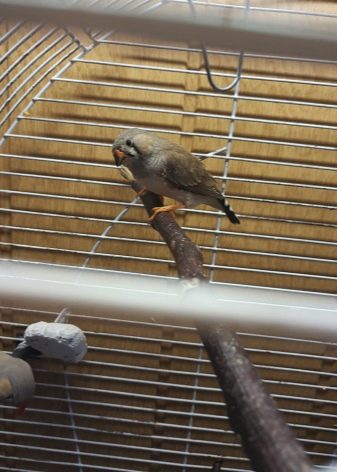

The room for keeping amadins should have the following equipment:
- feeders;
- drinking cups;
- forage jar of mineral type;
- nesting device;
- perches.
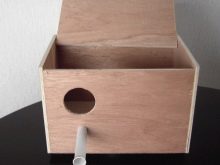
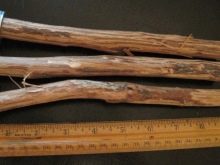
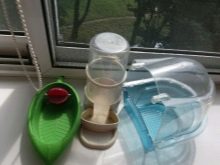
The best feeders and drinkers are glass, plastic, porcelain. It is better to refuse products made of clay, copper, wood - they are less hygienic. The poles are made of soft wood, well suited for:
- Linden;
- aspen;
- willow;
- elder.
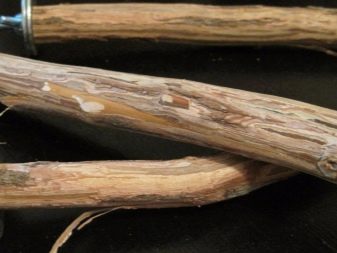
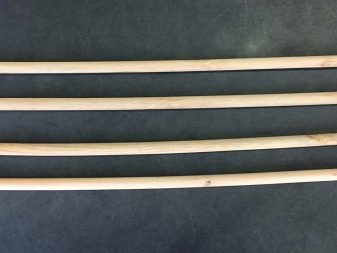
The bottom of the cage or the floor of the aviary is covered with bedding from:
- sand;
- sawdust;
- shavings;
- paper.
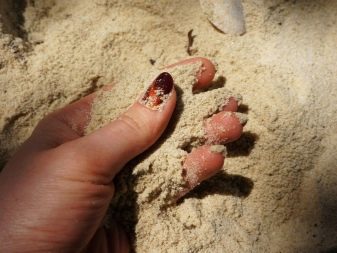
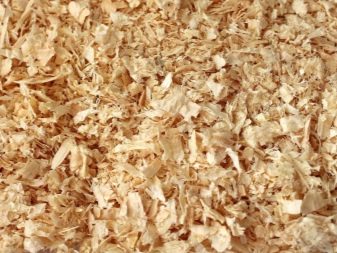
What and how to feed?
In order for the birds to develop well and be healthy, it is necessary to feed them efficiently and correctly. Balanced feeds can be found commercially or formulated yourself.
Grain mixtures are the main part of the diet of finches... They consist of wild and cultivated plants - millet, canary seed, weed seeds, chumiza, mogar. It is important that the seeds are fresh, without a musty smell.
Animal feed is an additional part of the diet. They consist of maggots, meal worms, fruit flies, insect larvae, minced meat, egg yolk, cottage cheese.
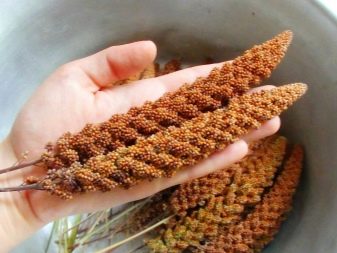

Learning to soft foods should be gradual. They are prepared daily, as they immediately deteriorate. Such a mixture consists of boiled eggs, grated carrots, cottage cheese, white bread.
The composition of the grain mixtures can vary: they include sunflower, oilseeds, rapeseed.
In captivity, the full range of natural bird feed is not available. Learning to new types of feed mixtures should be done gradually, increasing portions every day. All types of feed must be fresh.

Feeding is organized as follows:
- every morning the entire daily norm of the grain mixture is poured into the container;
- soft foods are given in small amounts throughout the day;
- every day the birds are given chopped fruits, berries, vegetables, herbs;
- the amount of food must be determined independently, since the need for food is individual for everyone;
- the average rate of grain mixture per individual is from one to one and a half teaspoons plus additional types of feed.
During the nesting period, birds are supplemented with a mixture of crackers, carrots with cottage cheese, yolk, dried insects.
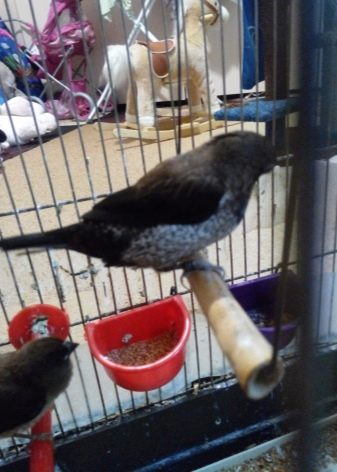

Sex differences and reproduction
Distinguishing the male finch from the female is very important if you are planning to breed. Boys and girls chicks are very similar, they can be distinguished by their singing. Females cannot sing, their conversation is limited to peculiar sounds, urges. Males dance when prompted, the plumage on the head rises, in addition, they whistle. Breeding finches is not too difficult, but you need to know the conditions and rules of this process. Reproduction can take place, regardless of the season, the size of the cycle usually does not exceed 55 days and consists of the following stages:
- preparatory;
- laying out and brooding;
- cultivation;
- detaching chicks.
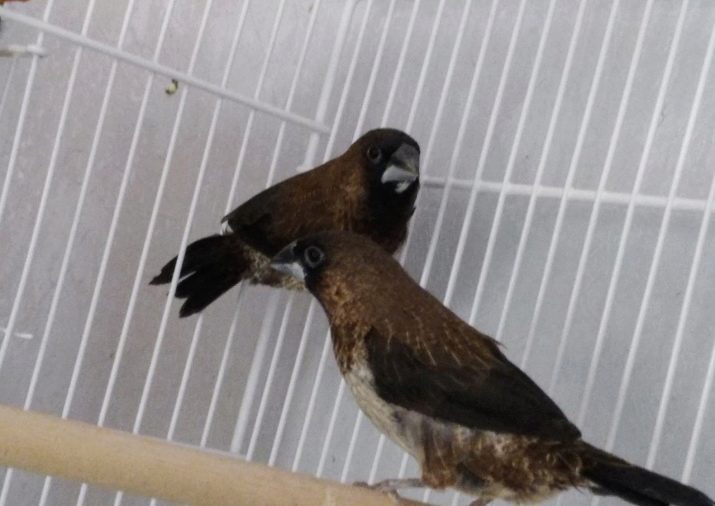
Features of the preparatory stage:
- health check of individuals;
- the age is taken into account, especially of the female;
- the minimum age is 9 months;
- it is better to provide a separate room for breeding;
- daylight hours should be artificially increased to stimulate the process up to 16 hours;
- food needs to be diversified by increasing the amount of animal protein;
- a nesting house with material inside must be present;
- add a mineral-type top dressing with a high content of calcium, phosphorus, vitamins to the diet;
- hay and coconut fiber are used as material for the interior decoration of the nest.

After the birds have become accustomed to the new location, mating and laying of eggs takes place. This period can take several days or even a couple of weeks. Laying eggs is a critical process and care must be taken to ensure that the fruit does not get stuck in the passage. This phenomenon is infrequent and fatal. When the process has begun, it is necessary to put a lamp over the cage, ensuring a high temperature in the room - about + 35 ° C.
Watch out for humidity - it should be high. If an egg is not laid within an hour or two, petroleum jelly or vegetable oil is carefully introduced into the hole with a pipette. After laying, the incubation period begins.

Features of incubation:
- amadins have a well-developed instinct, so there are usually no problems;
- after laying 4 eggs, the process begins;
- during this period, the egg is excluded from the diet;
- the period lasts about two weeks.
Growth and development of chicks:
- hatch naked, blind;
- an egg is again introduced into the parents' diet;
- green feed is removed;
- in a week, the chicks will already get stronger, they begin to see, plumage appears in its embryonic state;
- at 18 days, the plumage completely covers the chicks;
- and after 3-4 days they fly out of the nest.

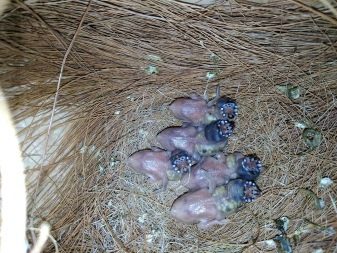
Disconnection and transition to a self-powered type occurs gradually. At first, the parents still feed the children. After a couple of days, the chicks themselves begin to try to peck, after about two weeks they will feed on their own. During this period, a pair of parents may start laying eggs again, so chicks are a hindrance. Disconnect them to another room.
Birds molt for the first time at the age from one and a half to three months, in the same period, males begin to sing, birds can be distinguished by gender.
After 3, maximum 4 breeding periods, the couple needs to rest for about a year. At this time, the house, the nest is cleaned, the daylight hours are shortened, the birds are placed in a cage with other individuals. In extreme cases, the couple is separated.

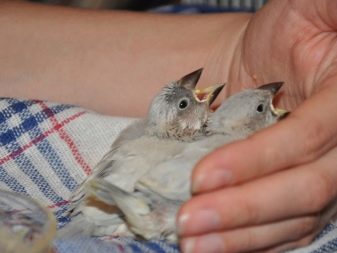
For the features of Japanese finches, see below.







